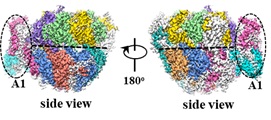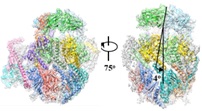Sophisticated pathways within cells control and regulate the
biogenesis, trafficking and
degradation of proteins to ensure protein homeostasis (proteostasis). Protein homeostasis within plastids is essential for photosynthesis and is strategically regulated by the protein quality control system involving multiple chaperones and proteases. Molecular chaperones assist new polypeptide chains to fold, while proteases degrade substrate proteins which cannot fold or refold to the native state. Among them, the ClpP proteases in plastids is complicated in its composition and architecture.
Wang et al, from Institute of Genetics and Developmental Biology, Chinese Academy of Sciences, reported an elegant Cryo-EM structure of the chloroplast ClpP complex from Chlamydomonas reinhardtii.
The ClpP core consists of double rings that do not show any symmetry. The top ring contains one ClpR6, three ClpP4 and three ClpP5 subunits while the bottom ring is composed of three ClpP1C subunits and one each of the ClpR1-4 subunits. ClpR3, ClpR4 and ClpT4 subunits connect the two rings and stabilize the complex. Furthermore, the chloroplast Cpn11/20/23 co-chaperonin, a co-factor of Cpn60, forms a cap on the top of ClpP. The co-chaperonin complex interacts with ClpP in a slight tilt manner by protruding the mobile loops into the hydrophobic clefts located on the surface of ClpP top ring, thereby repressed ClpP proteolytic activity.
The researchers have discovered a novel function of the Cpn60 co-chaperonin in addition to its known function in promoting folding: slowing down the degradation activity of chloroplast ClpP by capping the substrate entrance.
Cryo-EM structure of the chloroplast ClpP and ClpP-Cpn11/22/23 complexes (Image by IGDB)
Contact:
Dr. Cuimin Liu
Institute of Genetics and Developmental Biology, Chinese Academy of Sciences

 Cryo-EM structure of the chloroplast ClpP and ClpP-Cpn11/22/23 complexes (Image by IGDB)Contact:Dr. Cuimin LiuInstitute of Genetics and Developmental Biology, Chinese Academy of SciencesEmail: cmliu@genetics.ac.cn
Cryo-EM structure of the chloroplast ClpP and ClpP-Cpn11/22/23 complexes (Image by IGDB)Contact:Dr. Cuimin LiuInstitute of Genetics and Developmental Biology, Chinese Academy of SciencesEmail: cmliu@genetics.ac.cn CAS
CAS
 中文
中文




.png)
